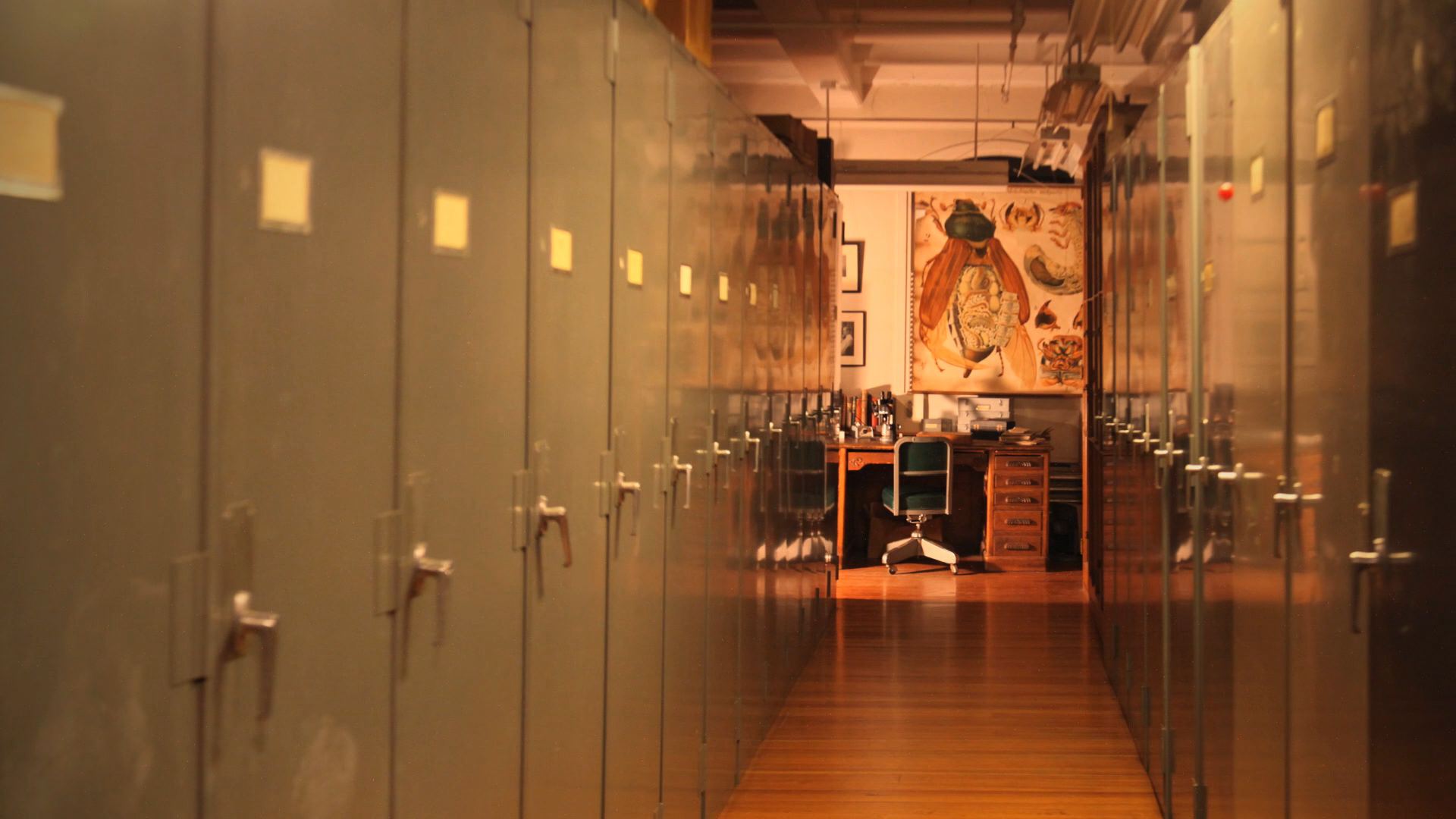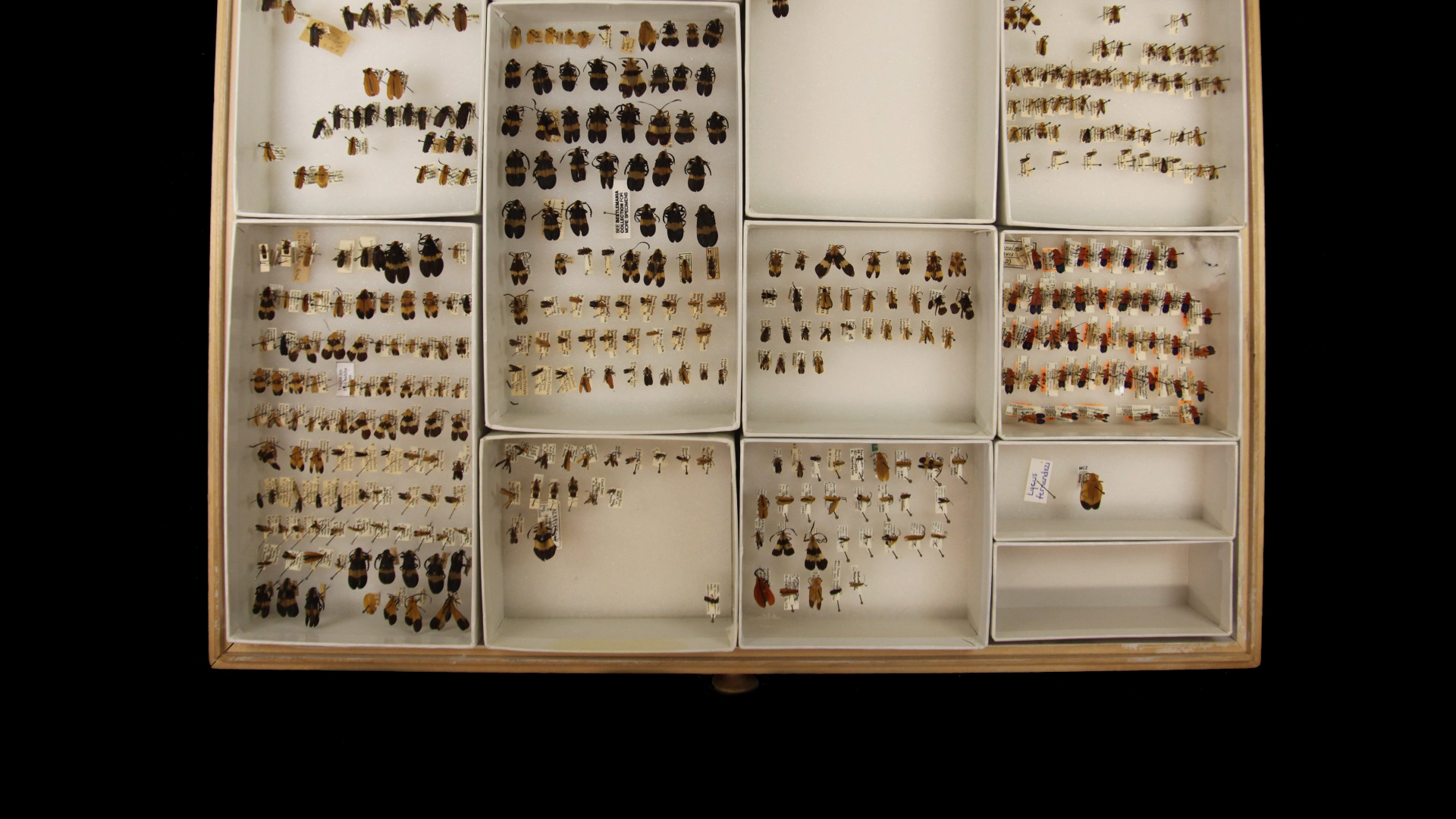ABOUT THE FILM
Beetle Bluffs brings to life the stories that accompany each specimen within a natural history collection by illuminating the dynamics of nine beetle mimics and their wary lizard predator. Beetle Bluffs is a film by Anna Lindemann, developed in collaboration with Brian Farrell, Curator of Entomology at the Harvard Museum of Comparative Zoology. The film combines 2D and stop motion animation. Beetle Bluffs was completed in 2013. It was a year in the making.
Winner of the Golden Glovie High-Score Award in Fine Art & Conceptual
ABOUT THE MUSIC
The music for Beetle Bluffs was inspired by the beetle mimics' biology and Cuban habitat. The music loosely references Cuban percussion and was composed by Anna Lindemann using musical gene network algorithms developed by Eric Lindemann and Anna Lindemann. The algorithms were developed as part of an ongoing exploration into the use of biological processes as a model for music composition. Anna and Eric use Random Boolean Networks (RBNs), which have been widely used in scientific research as simple models of biological systems. Their work with RBNs has focused on hierarchical systems with interconnected sub-networks running at different time-scales. Their models are simulated in Matlab and sonified using a variety of music synthesis techniques.
About Darlington’s Beetles
Beetle Bluffs is inspired by a pioneering paper on beetle mimicry by Philip J. Darlington Jr. (1904 – 1983). “Experiments on Mimicry in Cuba, with Suggestions for future Study” was published in 1938 in Transactions of the Royal Entomological Society of London. The paper discusses experiments Darlington conducted during four trips to Cuba from 1926 to 1936 that document an Anolis sagrei lizard avoiding toxic red and blue Lycid beetles, and seven varieties of Lycid beetle mimics, while feeding readily on various brown beetles.
At the time the paper was published, Darlington was Assistant Curator of Insects at Harvard’s Museum of Comparative Zoology (MCZ) in Cambridge, Massachusetts, home to one of the richest and historically most significant insect collections in North America. All but one of the nine original beetle specimens cited in Darlington’s paper are housed at the MCZ, but the eight specimens are distributed throughout the many drawers that hold the museum’s more than 7 million insects.
Only in Beetle Bluffs are the beetle specimens brought together to illuminate the story of the beetle mimics, and a possible evolutionary origin of their mimicry. Beetle Bluffs was filmed at the MCZ and features the beetle and lizard specimens referenced in Darlington’s paper, the original 1938 illustration plate by Mr. E. N. Fischer that accompanied Darlington’s paper, and Darlington’s field journal, diary, drawings, papers, map of Cuba, lantern slides, microscope, and desk.
ABOUT THE CHARACTERS
The lizard predator:
Anolis sagrei
The mimics (numbered according to the illustration plate by E. N. Fischer):
Thonalmus Suavis large female (Lycidae)
From Soledad, near Cienfuegos, Cuba (Cabinet 137, Drawer 172)Thonalmus Suavis small male (Lycidae)
From Soledad, near Cienfuegos, Cuba (Cabinet 137, Drawer 172)Tytthonyx rubidus female (Cantharidae)
From Buenos Aires, Trinidad Mountains, Santa Clara Province, Cuba (Cabinet 139, Drawer 9)Copidita thonalmus (Oedemeridae)
From Jaronú, Camagüey Province, Cuba (Cabinet 174, Drawer 22)Anoplischius venustus (Elateridae)
From Soledad, near Cienfuegos, Cuba (Not found in the collection)Calocosmus venustus (Cerambycidae, Lamiinae)
From Buenos Aires, Trinidad Mountains, Cuba (Cabinet 189, Drawer T94)Trichrous divisus (Cerambycidae, Cerambycinae)
From Buenos Aires, Trinidad Mountains, Cuba (Cabinet 187, Drawer T46)Heterops dimidiata (Cerambycidae, Cerambycinae)
From the north-western foothills of the Trinidad Mountains, Cuba (Cabinet 187, Drawer T46)Trichrous pilipennis (Cerambycidae, Cerambycinae)
From the north-western foothills of the Trinidad Mountains, Cuba (Cabinet 187, Drawer T46)
One of the brown beetles who meets a less fortunate fate:
Conoderus bifoveatus (Elateridae)
From Soledad, near Cienfuegos, Cuba (Cabinet 135, Drawer 2)
Screening & PUBLICATION History
2020 MEAS11: Manifest Exhibition Annual Season 11, anthology featuring the work of 216 artists who exhibited artwork during Manifest Gallery’s 11th season. The 368 works represented in the anthology were chosen from 6,991 works submitted across the year.
2016 Permanent collection at the State Darwin Museum, Moscow, Russia
2016 “Ecology Without Borders” Now&After’16 International Video Art Festival, The State Darwin Museum, Moscow, Russia — one of 28 films selected for the competition program from over 800 submissions from 63 countries
2016 “Model Organisms” inaugural issue of curated films from Labocine
2015 Evolution Film Festival, Evolution 2015 Conference, Guarujá, Sao Paulo, Brazil
2015 SCIENTIFICOUS juried international exhibition, Manifest Gallery, Cincinnati, OH
2015 Glovebox Short Film & Animation Festival, Cambridge, MA - winner of Golden Glovie High-Score Award in Fine Art & Conceptual
2014 7th Annual Imagine Science Film Festival, juried international festival New York, NY
Stills from Beetle BLuffs
Excerpts from Beetle Bluffs
SPECIAL THANKS
P.J. Darlington Jr., Katie Boronow, Gary Alpert, José Rosado, Patrick Gorring, Philip Perkins, Amie Jones, Bonnie Mettler, Eric Lindemann, Yohei Igarashi, Kiwi the Anolis lizard









